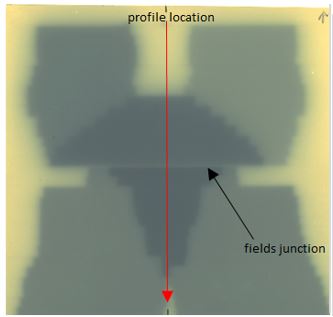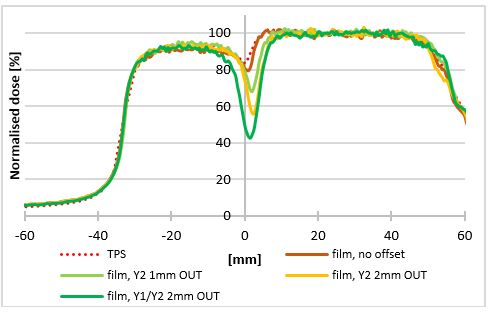Verification of hybrid VMAT plan robustness
Agnieszka Walewska,
Poland
PO-2049
Abstract
Verification of hybrid VMAT plan robustness
Authors: Paulina Wesołowska1, Edyta Fujak1, Agnieszka Walewska1, Dominika Bodzak1, Paweł Kukołowicz1, Anna Zawadzka1, Marta Fillmann1
1The Maria Sklodowska-Curie National Research Institute of Oncology, Medical Physics Department, Warsaw, Poland
Show Affiliations
Hide Affiliations
Purpose or Objective
This study aims to evaluate the robustness of hybrid VMAT (H-VMAT) plans for breast patients treated with lymph node region. The main focus is put on the dose distribution measurement in the junction of abutting 3D/VMAT fields where undesirable cold/hotspots may occur.
Material and Methods
The H-VMAT plan consists of four static fields and two VMAT arcs. The plan was calculated in Eclipse TPS (AAA v.15.6, Varian) for TrueBeam linac (Varian) equipped with Millenium 120 MLC. To assess the influence of jaw positions on the dose distributions, several measurements were done. Firstly, measurements of the H-VMAT plan were performed in chest phantom with EBT3 films in two transverse planes; one in the junction of the fields and second: 3 cm farther. Secondly, the static part of H-VMAT plan, and also the plans with an Y jaws offset of 1 and 2 mm were measured with EBT3 films positioned in a solid water phantom for 0° gantry angle (Fig 1). Additionaly the junction of the two open abbuting fields was evaluated, as it is susceptible to even small geometric misalignment of the jaws. Three dosimetrically equivalent linacs’ jaw settings were compared using simple plan with two open abutting fields. The junction in X and Y directions was tested for 0°/90° collimator and 0° gantry angles using EBT3 film positioned in a solid water phantom. Differences in relative dose in junction region were evaluated. The short-term reproducibility (ten consequtive irradiations) and long-term reproducibility (one irradiation per day for a week) was verified on one linac.

Fig 1. Static part of the plan irradiated on EBT3 film.
Results
The film analysis from the chest phantom gave the gamma passing rate (3%, 3mm) of 100% and 54,9% - with lower results in the junction plane. The dose drop in the junction showed underdosing of around 4%. Dose distribution verification of junctions for static part of H-VMAT plan without jaws offset showed 3.7% relative dose difference to TPS, and for 2 mm offset in Y1 and Y2 - 40% (the summary of results is shown in Fig 2). Additional measurements of simple abutting fields showed an underdosage of 4% to 17% depending on a linac. The short-term reproducibility gave the mean underdosing of 10.9% ± 0.7% and 14.9% ± 0.7% for junctions in X and Y jaws direction, respectively. The long-term reproducibility gave slightly larger deviations of 12.0%±1.0% and 14.6%±1.1% for junctions shaped with X jaws and Y jaws, respectively.

Fig 2. Profiles passing through the field junction.
Conclusion
The junction of the abutting fields is a critical parameter for the H-VMAT plans. The jaw settings must be regularly checked on every linac to verify that they are in the optimal range for hybrid plans performance. Jaw setting at max tolerance (2 mm) would increase dose drop to an unacceptable level. The underdosing measured for abutting fields was at the level which allows the introduction of hybrid plans for clinical treatments.